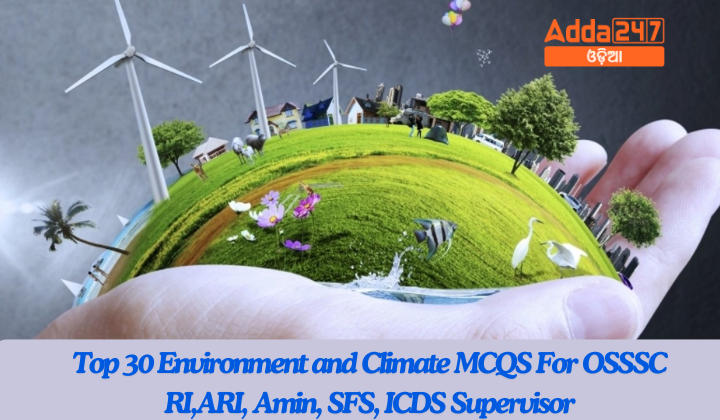Preparing for competitive exams like OSSSC RI, ARI, Amin, SFS, and ICDS Supervisor often requires a strong understanding of various subjects, including Environment and Climate. Here are 30 multiple-choice questions (MCQs) to help you prepare effectively.
Top 30 Environment and Climate MCQS For OSSSC RI,ARI, Amin, SFS, ICDS Supervisor
- Which of the following statements is correct about achieving sustainable development?
(a) Sustainable development can be achieved by restricting the usage of renewable resources
(b) Sustainable development can be achieved by controlling the growth rate of the world’s population
(c) Sustainable development can be achieved by controlling the menace of pollution
(d) All of the above
Answer: (d) - Which of the following statements is true about global warming?
(a) Global warming has led to large scale deforestation
(b) Global warming has led to a rise in the sea levels
(c) Global warming has led to a rapid increase in the population across several countries
(d) Global warming has led to a huge amount of waste generation
Answer: (b) - Which of the following was the main purpose behind setting up the Central Pollution Control Board (CPCB)?
(a) The main purpose of the Central Pollution Control Board was to regulate air pollution
(b) The main purpose of the Central Pollution Control Board was to regulate water pollution
(c) The main purpose of the Central Pollution Control Board was to regulate noise pollution
(d) The main purpose of the Central Pollution Control Board was to regulate deforestation
Answer: (a) - Which of the following statements is correct?
(a) Tides are a conventional source of energy
(b) The Sun is a conventional source of energy
(c) Wind is a conventional source of energy
(d) Dried dung is a conventional source of energy
Answer: (d) - Which of the following statements about the ozone shield is accurate?
(a) Ozone shield is found in the troposphere
(b) Ozone shield is found in the stratosphere
(c) Ozone shield is found in the exosphere
(d) Ozone shield is found in the mesosphere
Answer: (b) - Which of the following statements is true about ozone layer depletion?
(a) Ozone layer depletion leads to the problem of skin cancer within humans
(b) Ozone layer depletion results in a lower amount of production of phytoplankton
(c) Ozone layer depletion hampers the growth of terrestrial plants
(d) All of the above
Answer: (d) - Which of the following statements is true?
(a) Ozone depletion is one of the main reasons for soil erosion
(b) Deforestation is one of the main reasons for soil erosion
(c) Air pollution is one of the main reasons for soil erosion
(d) Global warming is one of the main reasons for soil erosion
Answer: (b) - Which of the following statements is true?
(a) The Central Pollution Control Board has identified twenty-five industrial categories as significantly polluting
(b) The Central Pollution Control Board has identified thirty-five industrial categories as significantly polluting
(c) The Central Pollution Control Board has identified forty-five industrial categories as significantly polluting
(d) The Central Pollution Control Board has identified seventeen industrial categories as significantly polluting
Answer: (d) - Which of the following statements is true?
(a) Economic growth is the modern concept for development
(b) Political growth is the modern concept for development
(c) Sustainable growth is the modern concept for development
(d) Social growth is the modern concept for development
Answer: (c) - Which of the following statements is correct?
(a) Global warming is a result of ozone layer depletion
(b) Global warming is a natural phenomenon
(c) Global warming is defined as the rise in the average temperature of the surface of the Earth
(d) Global warming is simply another term that scientists use to describe the greenhouse effect
Answer: (c) - Which of the following statements is correct?
(a) The Chipko movement was about banning the use of chlorofluorocarbon, bromine, and chlorine compounds
(b) The Kyoto Protocol was about banning the use of chlorofluorocarbon, bromine, and chlorine compounds
(c) The Appiko movement was about banning the use of chlorofluorocarbon, bromine, and chlorine compounds
(d) The Montreal Protocol was about banning the use of chlorofluorocarbon, bromine, and chlorine compounds
Answer: (d) - Which of the following statements about climate change is true?
(a) Plantation can be a preventive measure to tackle climate change
(b) The usage of cycles instead of bikes or cars for transportation can be a preventive measure to tackle climate change
(c) The usage of organic products can be a preventive measure to tackle climate change
(d) All of the above
Answer: (d) - Which of the following statements gives the correct meaning of absorptive capacity?
(a) Absorptive capacity is defined as the ability of our environment to absorb degradation
(b) Absorptive capacity is defined as the method of resource generation that is within the assimilating capacity of our environment
(c) Absorptive capacity is defined as the average number of organisms that are living within a given environment
(d) Absorptive capacity is defined as the minimum population that is currently surviving in the world
Answer: (a) - Which of the following is true about the environment?
(a) The environment includes only biotic factors
(b) The environment includes only abiotic factors
(c) The environment includes both biotic and abiotic factors
(d) The environment includes neither biotic nor abiotic factors
Answer: (c) - Which of the following statements is true?
(a) The United Nations Conference on Climate Change was held in India in the year 1997
(b) The United Nations Conference on Climate Change was held in Japan in the year 1997
(c) The United Nations Conference on Climate Change was held in China in the year 1997
(d) The United Nations Conference on Climate Change was held in Canada in the year 1997
Answer: (b) - Which one of the following causes global warming?
a) Carbon dioxide
b) Oxygen
c) Nitrogen
d) Hydrogen
Answer: a
Explanation: About 75% of the solar energy reaching the earth is absorbed by the earth’s surface, and the rest radiates back to the atmosphere. Some of the heat is trapped by greenhouse gases such as carbon dioxide, which is released by various human activities. - How many percent of carbon dioxide has increased in the atmosphere since pre-industrial times?
a) About 10%
b) About 20%
c) About 30%
d) About 40%
Answer: c
Explanation: The carbon dioxide in the atmosphere has increased by about 30% since pre-industrial times, causing more heat to be trapped in the lower atmosphere. Human activities, industrialization, and population growth are the main reasons. - What is the full form of UNFCC with respect to the global warming convention?
a) United Nations Framework Convention on Climate Change
b) United Nations Federation Convention on Climate Change
c) United Nations Framework Center on Climate Change
d) United Nations Federation Center on Climate Change
Answer: a
Explanation: In order to control the continuous increase in the carbon dioxide level, many countries have signed a convention to reduce greenhouse gases under the United Nations Framework Convention on Climate Change (UNFCC). - Who measures the global warming rate?
a) Astrologers
b) Physicist
c) Philosopher
d) Climatologist
Answer: d
Explanation: Global warming is usually calculated by climatologists. Global warming is accelerating faster than that calculated by climatologists. It was predicted in 1995 that in the 21st century, there would be a rise in temperature by 3.5 to 10 degrees Celsius. - Which one of the following results takes place due to global warming?
a) Maintaining steady temperature
b) Changes in the rainfall
c) Pleasant environment
d) Causing less pollution
Answer: b
Explanation: Global warming leads to changes in temperature and also changes the amount of rainfall, causing various problems. These fluctuations in rainfall can lead to either floods or droughts. - Human activities cause global warming.
a) True
b) False
Answer: a
Explanation: Human activities during the last few decades of industrialization and population growth have seriously polluted the atmosphere to the extent that it has begun to seriously affect vegetation and organisms in the environment. - Which one of the following causes global warming?
a) Radiative forcing
b) Earth gravitation force
c) Oxygen
d) Centripetal force
Answer: a
Explanation: Radiative forcing is a measure of the influence of a given climatic factor that has an amount of downward-directed radiant energy. Global warming is caused by a change in the fraction of the radiation reaching the surface of the earth. - How has human activity influenced global warming?
a) By planting more trees
b) By causing changes in gravitational force
c) By changing the radiative balance governing the Earth
d) By protecting the environment
Answer: c
Explanation: Human activity has influenced global surface temperature by changing the radiative balance governing the Earth on various timescales. The introduction of greenhouse gases to the environment results in greater damage to the environment. - Which one of the following is the anthropogenic radiative forcing of climate?
a) Aerosols
b) Cement
c) Paper
d) Glass
Answer: a
Explanation: Aerosols represent an important anthropogenic radiative forcing of climate. Collectively, aerosols block, reflect, and absorb a portion of incoming solar radiation. This also creates negative radiative forcing. - Which one of the following land uses causes global warming?
a) Increase in the fertility of soil
b) Surface reflectance
c) Forestation
d) Adopting organic farming
Answer: b
Explanation: The most direct way in which changes in land use can influence global warming is surface reflectance or Earth albedo. For example, surface reflectance is affected by the replacement of forests with cropland. - Changes in the composition of the atmosphere is an example of:
a) Internal forcing
b) External forcing
c) Mid forcing
d) Gravitational forcing
Answer: b
Explanation: The climate system generates random changes in global temperature for years to decades at a time, but long-term changes emanate only from external forcing. An increase in the concentration of greenhouse gases is an example of external forcing, including changes in the composition of the atmosphere. - What is the main reason for the melting of ice sheets?
a) Increase in the oxygen content
b) Global warming
c) Decrease in carbon dioxide content
d) Noise pollution
Answer: b
Explanation: Global warming is affecting various places around the world. It has accelerated the melting of ice sheets, permafrost, and glaciers, thereby causing a rise in the average sea levels to a greater extent continuously. - Which one of the following is the effect of global warming?
a) Maintaining sea level
b) Proper rainfall
c) Desertification
d) Afforestation
Answer: c
Explanation: Desertification is one of the effects of global warming. It causes water shortages and an intense amount of distress in the dry regions, which are degraded into deserts. This process is called desertification. - Soot only warms Earth’s climate system.
a) True
b) False
Answer: b
Explanation: Soot can either cool or warm Earth’s climate system, depending on whether it is airborne or deposited. Atmospheric soot directly absorbs solar radiation, which heats the atmosphere and cools the surface.





